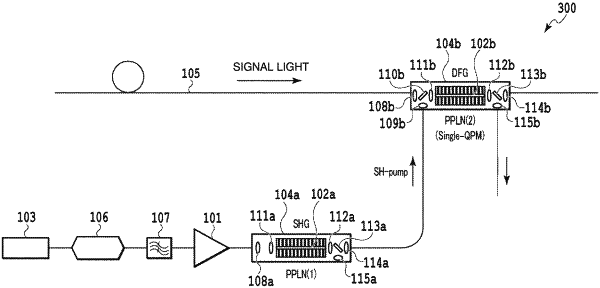| CPC G02F 1/377 (2013.01) [G02F 1/39 (2013.01)] | 8 Claims |

|
1. An optical signal processing device comprising:
a light source which generates a fundamental wave light;
an optical modulator which modulates the fundamental wave light, and generates a fundamental wave light having a plurality of carriers which are synchronized in phase;
an optical filter which transmits required components among the plurality of carriers;
a first second-order nonlinear optical element on which a light which passes through the optical filter is incident, and which generates a second harmonic of the fundamental wave light; and
a second second-order nonlinear optical element on which a signal light and the second harmonic are incident, and which performs nondegenerate parametric amplification, wherein
a waveguide of the first second-order nonlinear optical element and a waveguide of the first second-order nonlinear optical element have a periodically poled structure, and
the second second-order nonlinear optical element has an output unit for picking up a wavelength converted light corresponding to difference in frequency between the signal light and the second harmonic or an amplified light of the signal light,
the optical signal processing device further comprising a quasi-phase matching wavelength conversion element which is a wavelength conversion device which generates a differential frequency light having a wavelength λ2 which corresponds to differential frequency between the signal light having a wavelength λ1 and an excitation light having a wavelength λ3, and performs parametric amplification of the signal light having the wavelength λ1, the wavelength conversion device including: means for generating excitation lights having wavelengths λ3,i (i=−n , , , −2, −1, 0, +1, +2 , , , +n); and means for multiplexing the excitation lights and the signal light, the wavelength conversion device being configured such that the signal light having the wavelength λ1 and the excitation lights having the wavelengths λ3,i are incident on the wavelength conversion device and the wavelength conversion device performs parametric amplification of the signal light using the excitation lights, and assuming a modulation cycle of spatial distribution of a nonlinear constant of the quasi phase matching wavelength conversion element as Λ, a following equation is satisfied between a propagation constant β(λQPM) at a quasi-phase matching wavelength λQPM and a propagation constant β(2λQPM) at a wavelength 2λQPM,
 at least one of the wavelengths λ3,i of the excitation lights has a shorter wavelength than the quasi phase matching wavelength λQPM, and
a following equation is satisfied between a propagation constant β (λ3,i) at the wavelength λ3 of the excitation light, a propagation constant β (λ1) at the wavelength λ1 of the signal light and a propagation constant β (λ2) at the wavelength λ2 of the differential frequency light,
 |